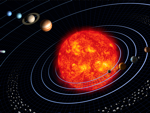Space is big. You just won't believe how vastly, hugely, mind- bogglingly big it is. I mean, you may think it's a long way down the road to the chemist's, but that's just peanuts to space.-Douglas Adams, The Hitchhiker's Guide to the Galaxy
I try to stress both memory and understanding on this blog, so I thought it might be fun to take a look at what astronomical scale really means in human terms.
Let's start in what you might term our own immediate neighborhood, with the Earth and the moon.
You might imagine that if the Earth were scaled down to, say, the size of a billiard ball. You might imagine that it would roll poorly, especially due to the mountains. Surprisingly, the Earth is actually smoother than a billiard ball, and if you don't believe me, you can click for yourself and check it out here.
Let's try a slightly larger ball. A regulation NBA basketball is 53.394 million times smaller than the earth. In other words, 1 inch on a basketball would scale up to 842.7 miles on the Earth (...or, a little less than the distance the Proclaimers would walk)!
If you scaled down the moon by the same factor, to what size ball would it be comparable? It's probably not to hard to guess that a tennis ball is about the right size. Here's a tougher question, though: If you wanted to scale down the distance from the Earth to the moon, how far away would you have to put the moon tennis ball away from the Earth basketball?
Surprised? Based on the average distance from the Earth to the moon, along with our scaling factor, the actual proper distance is about 23.66 feet, or more than two stories away. If you think that scale is big, we're about to get bigger.
Since we're talking about distances, let's try the entire solar system. Usually, when we see a picture of the solar system, it looks something like the NASA image in the upper left corner of this post, with the planets spread evenly apart. Just as with the Earth and the moon, that's not a true picture.
What happens if you scale down the sizes of the Sun, the planets, and their respective distances? Bill Nye demonstrates the scale with help from some models and his bicycle:
Even with a video demonstration like that, and the accurate measurement, you have to realize that they compressed the time to ride from one another to keep it interesting. To get a more immediate idea of the true distances, there's this site, which represents a 1-million-mile distance as a single pixel. This site, however, doesn't show the true relative sizes of the planets, since they're all represented by a single pixel.
If you think you can handle a site that gets both the relative sizes AND distances correct, check out phrenopolis.com's online solar system model. This model, on my screen, is about 1/7 billionth of the actual size. Even on that tiny scale, it took my browser 9 full seconds just to scroll to Mercury!
Ever seen the opening to the 1997 movie Contact? If you watch, you can easily see that either the trip through is speeding up, or that the solar system is not to scale. There's also another problem of scale in the intro, which is surprising, considering that the original story was written by Carl Sagan.
As you pass various astronomical bodies, radio sounds are playing, as if those were the most recent radio signals you could receive near those planets. By the time Saturn comes into view, we're listening to Volare, which first became a hit in 1958. So, is Saturn really just now getting 39-year-old radio signals?
Sorry, but that's not the case. Like all other types of waves in the electromagnetic spectrum, radio waves travel at the speed of light. Assuming you could exist on Saturn, and tune in Earth radio signals (while accounting for obstacles such as signal attenuation), you'd be listening with only an approximately 80-minute delay. Even Neptunian radio listeners, with a 4 hour and 10 minute delay (or so), could sing this week's musical hits, although Earth dwellers would still be more up to score on the day's Earth sports games.
If you really want an accurate and all-encompassing sense of scale, check out the classic education film, Powers of 10, keeping in mind the scale of 1 light year to 1 year ago for radio (and all other electromagnetic) waves:





No Response to "Astronomical Scale"
Post a Comment